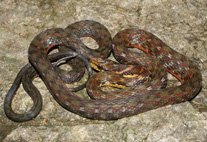Abstract
Natrix clerki Wall, 1925, previously known from its sole holotype and considered a synonym of Amphiesma parallelum (Boulenger, 1890), is resurrected in the genus Amphiesma on the basis of the analysis of morphological variation in 28 specimens of “Amphiesma parallelum” auctorum, plus six living, unvouchered specimens discovered in Arunachal Pradesh and Nagaland, India, and one vouchered specimen from Talle Valley in Arunachal Pradesh. Specimens from northeast India (Nagaland), northern Myanmar, and China (Yunnan), previously identified as Amphiesma parallelum either in the literature or in museum’s catalogues, are also here referred to A. clerki. The holotype of Amphiesma clerki is redescribed. As a consequence, the definition of Amphiesma parallelum is modified. A. parallelum inhabits the Khasi Hills and Naga Hills in Northeast India, whereas A. clerki has a wider range in the Eastern Himalayas, northern Myanmar and Yunnan (China). Amphiesma clerki differs from A. parallelum by its longer tail, dorsal scales more strongly keeled, scales of the first dorsal scale row strongly keeled vs. smooth, a postocular streak not interrupted at the level of the neck, and a much more vivid pattern on a darker background colour. Characters of species of the Amphiesma parallelum group, i.e. A. clerki, A. parallelum, A. bitaeniatum, A. platyceps and A. sieboldii are compared. A key to this group is provided.

